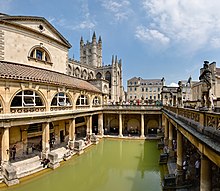Aquae Sulis

- For the Roman Baths complex at Aquae Sulis, see Roman Baths (Bath).
Aquae Sulis was a small town in the Roman province of Britannia. Today it is known as Bath, located in the English county of Somerset.
Development
Baths and temple complex

The Romans probably occupied Aquae Sulis shortly after their invasion of Britain in AD 43, attracted by the large natural hot spring which had been a shrine of the Celtic Brythons, dedicated to their goddess, Sulis. This spring was a natural mineral spring found in the valley of the Avon River in Southwest England. The name is Latin for "the waters of Sul." The Romans identified the goddess with their goddess and encouraged her worship. The similarities between Minerva and Sulis helped the Celts adapt to Roman culture. The spring was built up into a major Roman Baths complex associated with an adjoining temple. About 90 messages to Sulis scratched onto lead curse tablets (defixiones) have been recovered from the Sacred Spring by archaeologists. They were written in Latin, and usually laid curses upon those whom the writer felt had done them wrong. This collection is the most important found in Britain.
Town status

It was the religious settlement, rather than the road junction further north, which was given defensive stone walls, probably in the 3rd century. The area within was largely open ground, but soon began to be filled in. There is some dispute as to whether these new buildings were private dwellings or were associated with servicing the pilgrims to the temple. There was also a ribbon development along the northern road outside the walls and cemeteries beyond[1].
Decline
From the later 4th century on, the Western Roman Empire and its urban life declined. However, while the great suite of baths fell into disrepair, some use of the hot springs continued. After the Roman departure from Britain around AD 410, some residents seem to have remained, but they must have faced Saxon raids for, in the 440s, a young girl's severed head was thrust into an oven in Abbeygate Street. As far back as Geoffrey of Monmouth, the Arthurian Battle of Mons Badonicus (c. 500) has been suggested to have taken place near Aquae Sulis.[2] The Anglo-Saxon Chronicle records a King Ffernfael, who may have come from Aquae Sulis, being killed at the Battle of Dyrham in 577.[3]
Mediaeval legend
In mediaeval times, the Roman temple at Bath was incorporated into British legend. The thermal springs at Bath were said to have been dedicated to Minerva by the legendary King Bladud and the temple there endowed with an eternal flame.[4]
Remains
Rediscovered from the 18th century onward, the city's Roman remains have become one of the city's main attractions. They may be viewed almost exclusively at the Roman Baths Museum, which houses:
- Artefacts recovered from the Baths and the Roman town. There is a fine collection of stone sculptures.
- Excavated remains of the main temple courtyard.
- The Roman Baths themselves, though some lie below 18th century stonework. Of particular note is the original Roman Great Bath still lead lined and fed by the sacred spring through Roman lead pipes.
References
- ^ Burnham, Barry C (1990). The Small Towns of Roman Britain. London: B T Batsford.
{{cite book}}: Unknown parameter|coauthors=ignored (|author=suggested) (help) - ^ Mount Badon/Mons Badonicus
- ^ Ford, David Nash (1996). "The 28 Cities of Britain as listed by Nennius". Early British Kingdoms. Retrieved 2007-01-28.
- ^ Geoffrey of Monmouth. Historia Regum Britanniae, II:14.
